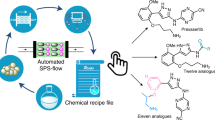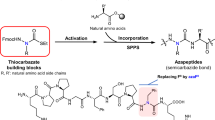Abstract
The large-scale commercial production of a 36-amino-acid peptide by chemical synthesis has been demonstrated in the development of enfuvirtide (T-20 or Fuzeon), a first-in-class membrane fusion inhibitor for the treatment of HIV. The rationale behind route selection and the scale-up of the process used to manufacture enfuvirtide are discussed.
This is a preview of subscription content, access via your institution
Access options
Subscribe to this journal
Receive 12 print issues and online access
$209.00 per year
only $17.42 per issue
Buy this article
- Purchase on Springer Link
- Instant access to full article PDF
Prices may be subject to local taxes which are calculated during checkout




Similar content being viewed by others
References
Kelley, W. S. Therapeutic peptides: the devil is in the detail. Biotechnol. 14, 28–31 (1996).
Fields, G. F. and Nobel, R. L. Solid phase peptide synthesis utilizing 9-fluorenylmethoxycarbonyl amino acids. Int. J. Peptide Protein Res. 35, 161–214 (1990).
Chan, W. C. & White, P. D. Fmoc Solid Phase Peptide Synthesis — A Practical Approach (Oxford University Press, Oxford, 2000).
Bodanszky, M. Principles of Peptide Synthesis (Springer, Heidelberg, 1993).
Merrifield, R. B. Solid phase peptide synthesis. 1. The synthesis of a tetrapeptide. J. Am. Chem. Soc. 85, 2149–2154 (1963).
Carpino, L. A. & Han, G. Y. 9-Fluorenylmethoxycarbonyl function, a new base-sensitive amino-protecting group. J. Am. Chem. Soc. 92, 5748–5749 (1970).
Carpino, L. A. & Han, G. Y. 9-Fluorenylmethoxycarbonyl amino-protecting group. J. Org. Chem. 37, 3404–3409 (1972).
Carpino, L. A. New amino-protecting groups in organic synthesis. Acc. Chem. Res. 6, 191–198 (1973).
Chang, C. D. & Meienhofer, J. Solid-phase peptide synthesis using mild base cleavage of N-α-fluorenylmethyloxycarbonylamino acids, exemplified by a synthesis of dihydrosomatostatin. Int. J. Pept. Protein Res. 11, 246–249 (1978).
Atherton, E. et al. A mild procedure for peptide synthesis: use of fluorenylmethoxycarbonylamino-acids. J. Chem. Soc., Chem. Comm. 13, 537–539 (1978).
Atherton, E., Fox, H., Harkiss, D. & Sheppard, R. C. Application of polyamide resins to polypeptide synthesis: an improved synthesis of β-endorphin using fluorenylmethoxycarbonylamino-acids. J. Chem. Soc., Chem. Comm. 13, 539–540 (1978).
Rink, H. Solid-phase synthesis of protected peptide fragments using a trialkoxy-diphenyl-methyl ester resin. Tetrahedron Lett. 28, 3787 (1987).
Immer, H. U. in Proceedings of the 11th American Peptide Symposium (eds Rivier, J. E. & Marshall, G. R.) 1054 (ESCOM, Leidon, 1990).
Florsheimer, A. & Riniker, B. in Peptide 1990 (Proceedings of the 21st European Peptide Symposium) (eds Giralt, E. & Andreu, D) 131–133 (ESCOM, Leiden, 1991).
Barlos, K. et al. Darstellung geshutzter peptid-fragmente unter einsatz substituierter triphenylmethyl-harze. Tetrahedron Lett. 30, 3943–3946 (1989).
Barlos, K. et al. Veresterung von partiell geschutzten peptid-fragmenten mit harzen. Einsatz von 2-chlortritylchlorid zur synthese von Leu15-gastrin I. Tetrahedron Lett. 30, 3947–3950 (1989).
Mergler, M., Nyfeler, R., Tanner, R., Gosteli, J. & Grogg, P. Peptide synthesis by a combination of solid-phase and solution methods II, synthesis of fully protected peptide fragments on 2-methoxy-4-alkoxy-benzyl alcohol resin. Tetrahedron Lett. 32, 4009–4012 (1988).
Barlos, K., Gatos, D. & Schafer, W. Synthesis of prothymosin α (ProTα) — a protein consisting of 109 amino acid residues. Angew. Chem. Int. Ed. Engl. 30, 590–593 (1991).
Riniker, B., Florsheimer, A., Fretz, H., Sieber, P. & Kamber, B. A general strategy for the synthesis of large peptides: The combined solid-phase and solution approach. Tetrahedron 49, 9307–9320 (1993).
Kang, M. C., Bray, B., Lichty, M., Mader, C. & Merutka, G. Methods and composition for peptide synthesis (T–20). US Patent 6,015,881 (2000).
Harre, M., Nickisch, K. & Tilstam, U. An efficient method for activation and recycling of trityl resins. React. Funct. Polymers 41, 111–114 (1998).
Benoiton, N., Lee, Y. & Chen, F. in Proceedings of the 12th American Peptide Symposium Peptides; Chemistry & Biology, 496–498 (ESCOM, Leidon, 1992).
Cameron, L., Holder, J., Meldal, M. & Sheppard, R. Peptide synthesis. Part 13. Feedback control in solid phase synthesis. Use of fluorenylmethoxycarbonyl amino acid 3,4-dihydroxy-4-oxo-1,2,3-benzotriazin-3-yl esters in fully automated system. J. Chem. Soc. Perkin Trans. 1, 2895–2901 (1988).
Milton, R., Milton, S. & Adams, P. Prediction of difficult sequences in solid-phase peptide synthesis. J. Am. Chem. Soc. 112, 6039–6046 (1990).
Knorr, R., Trzeciak, A., Bannwarth, W. & Gillessen, D. New coupling reagents in peptide chemistry. Tetrahedron Lett. 30, 1927–1930 (1989).
Konig, W. & Geiger, R. New method for the synthesis of peptides: Activation of the carbonyl group with dicyclohexylcarbodiimide by using 1-hydroxybenzotriazoles as additives. Ber. Dtsch. Chem. Ges. 103, 788 (1970).
Author information
Authors and Affiliations
Related links
Related links
FURTHER INFORMATION
Encyclopedia of Life Sciences
Rights and permissions
About this article
Cite this article
Bray, B. Large-scale manufacture of peptide therapeutics by chemical synthesis. Nat Rev Drug Discov 2, 587–593 (2003). https://doi.org/10.1038/nrd1133
Issue Date:
DOI: https://doi.org/10.1038/nrd1133
This article is cited by
-
Rational design of stapled antimicrobial peptides
Amino Acids (2023)
-
The minimal active domain of human salivary histatin 1 is efficacious in promoting acute skin wound healing
Military Medical Research (2022)
-
PDAUG: a Galaxy based toolset for peptide library analysis, visualization, and machine learning modeling
BMC Bioinformatics (2022)
-
Preparative Solid-Phase Method of S–S Bond Closure in Desamino-Analogs of Neurohypophyseal Hormones
Pharmaceutical Chemistry Journal (2022)
-
Recent advances in the synthesis of discrete oligomers and polymers: chemistry, strategy and technology
Science China Chemistry (2022)



